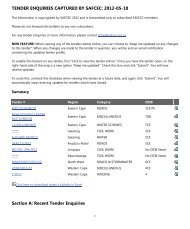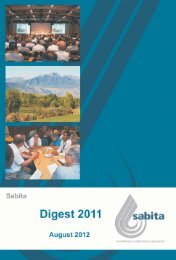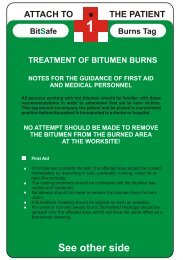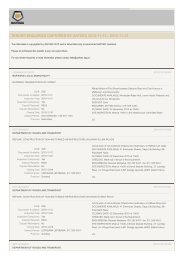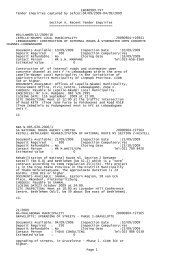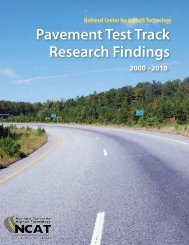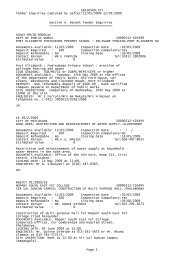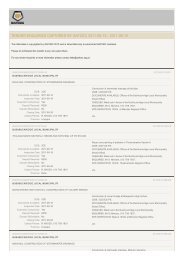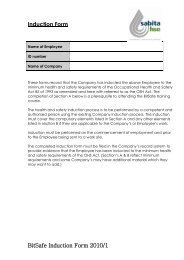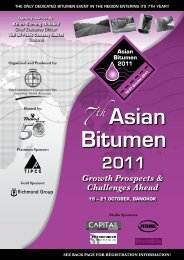DIGEST 2006 - Sabita
DIGEST 2006 - Sabita
DIGEST 2006 - Sabita
You also want an ePaper? Increase the reach of your titles
YUMPU automatically turns print PDFs into web optimized ePapers that Google loves.
we can economically test a<br />
possible investment:<br />
• The discount rate captures<br />
the opportunity cost of<br />
capital. In a sound<br />
investment, this must be less<br />
than the discount rate at<br />
which the present value of<br />
benefits and costs are equal,<br />
i.e. the internal rate of return<br />
(IRR).<br />
• We subtract the discounted<br />
costs from the discounted<br />
benefits so as to<br />
estimate the net<br />
present value<br />
(NPV) of the<br />
contemplated<br />
investment. This<br />
is the most<br />
direct way of<br />
comparing two<br />
types or<br />
instances of<br />
asset, such as a<br />
gravel road and<br />
a paved road:<br />
which has the<br />
higher NPV? It is<br />
immediately obvious that this<br />
form of comparison must be<br />
highly sensitive to the period<br />
of time over which we choose<br />
to estimate costs and<br />
benefits. One asset might pile<br />
up costs earlier than another<br />
but then deliver a better ratio<br />
of benefits to costs at later<br />
stages. How many of these<br />
later stages are factored into<br />
the calculation of NPV will<br />
then crucially influence the<br />
conclusion of our comparison.<br />
The key to effective economic<br />
analysis of any investment<br />
decision is finding a way to<br />
account for all consequences that<br />
have value to people or impose<br />
costs on them, even where the<br />
values and costs in question don’t<br />
have prices assigned to them<br />
directly by markets. Such<br />
non-traded cost and benefit<br />
streams must be assigned<br />
so-called ‘shadow prices’, that is,<br />
monetary amounts people appear<br />
willing to pay to avoid the costs<br />
and acquire the benefits.<br />
The key to<br />
effective economic<br />
analysis ... is<br />
finding a way to<br />
account for all<br />
consequences that<br />
have value to<br />
people or impose<br />
costs on them<br />
For example, if someone whose<br />
time can be sold<br />
on the consulting<br />
market for R1,000<br />
per hour spends<br />
two hours per<br />
month polishing<br />
their car, we can<br />
shadow price the<br />
value of a shiny<br />
car to that person<br />
at R24,000 per<br />
year.<br />
Bearing in mind<br />
that surfaced<br />
roads are<br />
relatively costly to build but<br />
relatively cheaper to maintain than<br />
gravel roads, we can identify the<br />
two general factors that have<br />
mainly contributed to overestimations<br />
of the economic value<br />
of gravel roads as compared to<br />
paved ones. The first is failure to<br />
consider long enough periods in<br />
calculating NPVs, or implicitly<br />
assuming too steep a discount<br />
rate (which amounts to the same<br />
thing). The second is failure to<br />
incorporate shadow prices for a<br />
range of non-traded benefits that<br />
flow from paved but not from<br />
gravel roads, or flow from gravel<br />
roads only to a lesser extent.<br />
19



